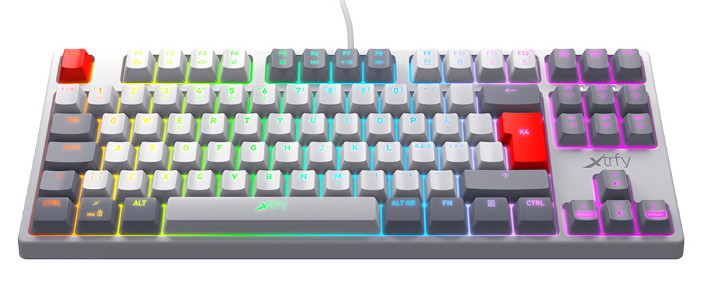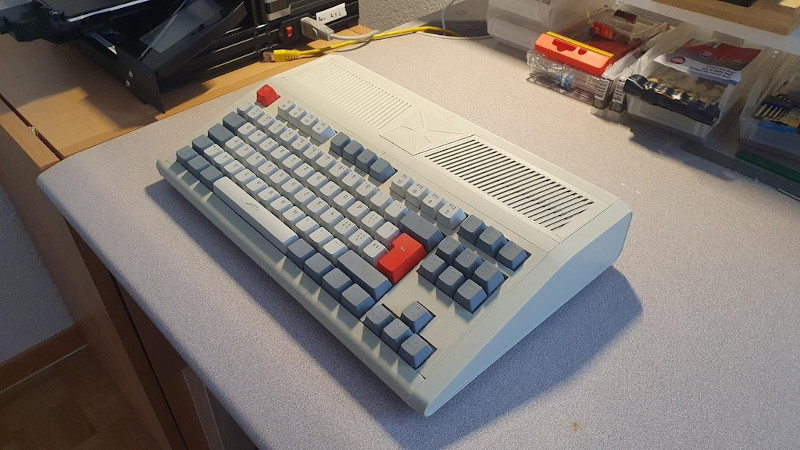The unique look of early desktop computer systems remains popular with a certain segment of geekdom, so it’s no great surprise when we occasionally see a modern hacker or maker unceremoniously chuck 40+ year old electronics from a vintage machine just to reuse its plastic carcass. We try not to pass judgement, but it does sting to see literal museum pieces turned into glorified Raspberry Pi enclosures.
But with a little luck, perhaps the Retro Wedge Computer case designed by [AndyMt] will be able to save a few of those veteran computers from an unnecessary lobotomy. As the name implies, this 3D printable model is designed to resemble “wedge” desktop computers such as the Atari ST, TI-994A, and Commodore 128. But don’t be put off by its considerable size — the model has been chopped up so no piece is larger than what can fit on a fairly standard 230 x 230 mm print bed.

Rather than tailor the design to one specific set of internals, [AndyMt] has wisely left that up to the end-user. There are no dedicated mounting points inside, nor is there a rear-panel. Once you figure out which single-board computer you want to put into this faux-retro box, designing those last parts will be up to you.
That said, the keyboard section is more specific, with the design focusing on a XTRFY K4 TKL RGB RETRO. While it’s not the cheapest mechanical keyboard we’ve ever seen, it does feature an era-appropriate color scheme which makes it uniquely well suited to this project.
Like attempts to recreate other forms of classic computers, it will obviously take more time and effort to print this case out than it would to look around on eBay for a donor Commodore C64 C. But given that those classic machines are only becoming more rare and valuable as time goes on, building it yourself will almost certainly be the cheaper option.
















Good idea!
Now if I can put my TS1000 in one.
If ever a computer needed a better keyboard, that’s the one.
i dont know what the obsession is with preserving what is effectively the e-waste of yesteryear. so long as a few functional museum pieces exist, who cares if you gut a few? and you usually need to in order to keep the museum pieces functioning. obviously the rare machines will be the most expensive and will not be suitable for gutting. something as ubiquitous as commodores or apple 2s, go nuts.
The ratio of pi butchers to interesting old specimens is too high. Those you mentioned aren’t anywhere near ubiquitous, and it won’t take long before you only get to see one in a museum (the pi butcheries make it into the trash can after a few years).
how do you know the systems butchered were anything more than non functional bricks? most retro computers are dependent on a few irreplaceable chips. the maximum number of functional systems is going to be capped by the least available part. so there are going to be a surplus of the other parts, the cases, the other more common chips. if you cant restore those systems, then maybe make use of the surplus components. its certainly better than throwing it our or letting it rot in storage.
Many of those irreplaceable chips are now retting reimplemented in hardware or software emulation (microcontroller or FPGA). Pop one of those in, and you can carry on using all the other components, without making them surplus.
there’s been a lot of advancement to replicate those chips, anyway I have been on the hunt for a number of machines over the years and I usually buy them broken.
The price actually becomes somewhat affordable, and it does hurt a little when I see one that I have been after have its useful surplus parts gutted to the trash can just to hot snot a pi in to it.
I am not preserving them, I just enjoy working on them and using them for my personal amusement
You loveless monster!
“who cares”
Nostalgia by those who want a favorite computer from their youth. Some restore them with FPGA module substitutes in place of defective custom parts they can no longer buy and there are even brand new reverse engineered C64, C128 (I think), and Amiga motherboards and cases in current production to swap over parts from a bad, original system.
A C64 on YouTube made with a modern manufacture case, PCB, and modern substitutes for the custom chips:
This Century’s First 100% New Commodore 64!
Jan 14, 2023
https://www.youtube.com/watch?v=Qhdc-jgwqVQ
I see others modding their Amigas to the point where we should ask if it is then anything more than an Amiga case and keyboard.
If I want to run anything from one of my old non-x86PC machines, I’ll just use an emulator.
We are past the time where those are ubiquitous trash. In the early 00’s I literally salvaged some Commodore 64s from the trash. Now go take a look at them on eBay.
I would say making sure these old computers continue to work and entertain does far more for reducing e waste. And broken machines are often the source of needed parts to keep other systems function, and that includes cases/shells.
It is possible to buy brand new C-64c cases from several companies. Just to put it out for those that do not have a 3d printer.
Have to admit that it is tempting. There are a lot of old computers I missed out on back in the day. I also want my own Commodore SuperPet but those are hard to get these days and will probably just emulate it.
Aaannnddd as usual all the files are stl, no STEP files for ease of modification.
Booo to stl.
Hackaday comment section strikes again…
These were meant to be top-level comments.
It’s designed in Blender so there can be no STEP.
…only Zuul.
I have no problems with editing STL in old Caligari trueSpace. First have to load them in a slicer to see the XYZ dimensions because trueSpace has a bug where when importing some formats it scales the model down so that the largest axis dimension = 8 of whatever the current model dimension is set to.
Since STL uses one unit, millimeters, I can model in millimeters, centimeters, or meters in trueSpace and when exported to STL one of any of those = 1mm. If I needed to do super fine detail I could set it to meters and model a sub-mm print. It’s easiest to set all the world scale to meters and the model scale to centimeters.
Since trueSpace has that import “feature”, once an STL is imported and scale corrected I save in its native COB format and do all the work on that, then export to STL to print.
It would be nice if Microsoft would release the trueSpace source code, minus the 3rd party parts Caligari licensed like the Lightworks render engine. At the time, trueSpace with Lightworks was priced less than just the Lightworks plugin for other 3D software.
i do cad work in 3d studio max. why? because i know its meshing tools. i get a stl file, no problem! i just import the model, check a known dimension for proper scaling (scale to the correct unit if necessary). then i can make mesh level modifications. also i dont like change.
ive used truespace back when i did freespace modding, but it liked to generate bad geometry (degenerate polies, or micropolies which should have just been collapsed) with its boolean operations where max usually does it more cleanly.
You can use freecad to convert them from STL to STEP. I have done it several times with great success.
ooh! Likey…
RPi? You could fit a whole laptop in that case along with the power brick!
You could fit a LattePande in there as well for a Win10/11 computer.
With the red keys and the vents on top I get a strong Acorn A3000 vibe.
https://en.wikipedia.org/wiki/Acorn_Archimedes#/media/File:Acorn_Archimedes_A3000_Computer_Main_Unit.jpg
That was my first thought too, although the case shape also works for the Commodore and Amiga
@irox:
Oooh! I remember those! Was lucky enough to have one, but like an idiot, I skipped it when I moved :(
Regretting that bitterly now :( I even had a couple of expansion packs for it, one of which was internal, but I cannot remember what it was for!
Hours of playing Lander, Elite, messing around with !Maestro… RISC OS was (is!) a nice OS to use and way ahead of its time, plus infinitely more stable than ****ows.
I rescued a Tandy CoCo2 case from the trash and it’s been sitting in the back of my shed for a long time now.
It is totally empty, no pcb, no power supply, not even the keyboard.
I think maybe the screw posts for the keyboard or maybe for holding it together are broken off, I don’t remember exactly been a long time.
I’m getting close to that layer as I try to declutter. I expect to be seeing it soon.
Should I try to repair the broken posts then look for a retro computer enthusiast who wants to use it as part of a restore?
Should I just pass it on as-is to that enthusiast?
Turn it into a Pi case?
Throw it away?
I remember it being very yellow and stained too, I wouldn’t want to look at it every day without retrobrite.
I don’t like throwing away or defacing “classic” stuff like this but I’m not interested in collecting all the missing pieces to make a CoCo either and I don’t know that there is a shortage of cases vs functional electronics to make the case repairs worthwhile.
I was a total Commodore junkie back in the 80’s and 90’s (except my original was the Timex Sinclair 1000) and I loved the look of my machines until I saw the USRobotics 9600 modem. Something about that black and red color scheme was really appealing. I wish someone would put some retro Commodore build out there with that kind of look. Even the red digital display was cool.
The TRS 80 Model 1 was a “wedge” computer but was not mentioned. It would be nice to see a TRS 80 clone board (not a Pi emulator) that could load and run TRS-Dos or DOS Plus and programs either by cassette or floppy.
If you want to build this but can’t buy that keyboard, I have good news for you. I think is “common desing” because I have the same keyboard, except brand and switches.